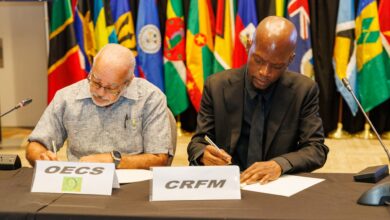Caribbean Community (CARICOM) Member States are being urged to exploit niche opportunities with “marketing savvy” in penetrating hemispheric markets such as the USA, which accounts for over 70 per cent of CARICOM’s global exports and imports.
According to the Caribbean Trade and Investment Report, 2000, which was recently launched by the Caribbean Community (CARICOM) Secretariat, the bulk of CARICOM trade is within the hemisphere, with the USA being the largest trading partner.
The Report which offers a detailed analysis of the Region’s trade performance intra-regionally, hemispherically, and globally, also reported that intra-CARICOM exports, as a percentage of their total global trade, doubled in 1990-1998, an achievement from 7.9 in 1990 to 15.5 in 1998. Additionally, intra-CARICOM exports as a percentage of their total hemispheric trade increased considerably during the same period. Intra-CARICOM share increased from 17.8 per cent in 1990 to 29.5 per cent in 1998, a slightly lower increase for intra-hemisphere trade compared with global trade.
The Report took note of the Caribbean supply capability needs to improve its position in the hemispheric arena, especially in relation to the USA, the Region’s key market source.
The Report indicated that CARICOM’s share of Hemispheric trade with the USA declined during the period under review, from 59.4 per cent in 1990 to 46.2 per cent in 1998. “While a fall in the share over time would be expected, given the CARICOM strategy of widening of trade relations to include more partners and the diversifying of export outlets, it is however disconcerting that the absolute value of CARICOM exports to the USA has hardly increased during the period”, according to the evaluation.
Continuing, the Report states that “only in two years, 1995 and 1996, was the value attained in 1990 actually surpassed. Mexico’s participation in NAFTA, with its lower costs of production and less restrictive rules of origin, has had a very adverse effect on exports out of Jamaica and other CARICOM countries to the USA market. In the 1990-1994 pre NAFTA period, CARICOM
manufacturing exports to the USA had risen sharply from US$283.8m to US$508.6m. In 1995 there was an increase to $531m and, thereafter, there was a fall every year reaching US$422m in 1998.”
The Report observed a similar circumstance in the case of Canada, where the value of CARICOM exports remained almost the same during the period, except for a significant jump in 1994.
The Report stated that CARICOM countries seem not to have made full use of the preferential access opportunities available to them within the Hemisphere. The USA and Canadian markets account for roughly one-half of CARICOM exports and CARICOM Member States nearly one-third, with the remaining trading partners representing approximately one-sixth. CARICOM has preferential market access arrangements with the USA, Canada, Venezuela and Columbia.
Additionally, it was reported that CARICOM’s relations with third countries, and the insertion of the Region into the hemispheric economic integration process, seem to be undergoing change,”…modified ostensibly to allow for a greater degree of flexibility in the liberalisation process”. It was noted that Trinidad and Tobago has initiated trade negotiations with Mexico and Costa Rica and is keen on making similar moves with Panama.
Accordingly, since 1997, countries that have achieved a greater degree of competitive readiness could seek the approval of the Council for Trade and Economic Development (COTED) under Protocol IV on Trade Policy to form trading agreements with certain third parties, even before the other member countries are ready to do so. It is expected that other countries will eventually catch-up and, in time, the single party agreement will evolve into a regional instrument.





